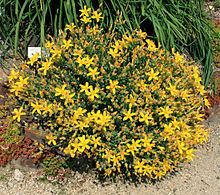Kingdom Plantae Family Hypericaceae Tribe Hypericeae Higher classification Hypericaceae | Order Malpighiales Subfamily Hypericoideae Scientific name Hypericum Rank Genus | |
 | ||
Lower classifications Perforate St John's‑wort, Hypericum calycinum, Hypericum androsaemum, Hypericum triquetrifolium, Hypericum canariense | ||
St john s wort hypericum growing st johns wort
Hypericum /ˌhaɪˈpiːrᵻkəm/ is a genus of flowering plants in the family Hypericaceae (formerly often considered a subfamily of Clusiaceae). Hypericum is unusual for a genus of its size because a worldwide taxonomic monograph was produced for it by Norman Robson (working at the Natural History Museum, London). Robson recognizes 36 sections within Hypericum.
Contents
- St john s wort hypericum growing st johns wort
- Hypericum hidcote spring pruning
- Description
- Taxonomy
- Sections
- Ecology
- Medical properties
- Plant health problems
- Fossil record
- References
The genus has a nearly worldwide distribution, missing only from tropical lowlands, deserts and polar regions. All members of the genus may be referred to as St. John's wort, and some are known as tutsan. The white or pink flowered marsh St. John's-worts of North American and eastern Asia are nowadays separated into the genus Triadenum.
Hypericum hidcote spring pruning
Description
There are 490 individual species in the genus. Hypericums vary from herbaceous annual or perennials 5–10 cm tall to shrubs and small trees up to 12 m tall. The leaves are opposite, simple oval, 1–8 cm long, either deciduous or evergreen. The flowers vary from pale to dark yellow, and from 0.5–6 cm in diameter, with five (rarely four) petals, most having prominent stamens. The fruit is usually a dry capsule which splits to release the numerous small seeds.
Some species are used as ornamental plants and have large, showy flowers. Numerous hybrids and cultivars have been developed for use in horticulture, such as H. × moserianum (H. calycinum × H. patulum), H. 'Hidcote' and H. 'Rowallane'. All of the above cultivars have gained the Royal Horticultural Society's Award of Garden Merit.
Taxonomy
Hypericum is a large genus, containing 400–500 species. Cultivars include Hypericum calycinum 'Hidcote' and Hypericum perforatum 'Anthos'.
Sections
Hypericum is broken up into 36 sections, each with its own subsections and species. They include:
Ecology
St. John's-worts can occur as nuisance weeds in farmland and gardens. On pastures, some can be more than a nuisance, causing debilitating photosensitivity, and sometimes abortion in livestock. The beetles Chrysolina quadrigemina, Chrysolina hyperici and the St. John's-wort Root Borer (Agrilus hyperici) like to feed on common St. John's-wort (H. perforatum) plants and have been used for biocontrol where the plant has become an invasive weed.
Hypericum species are the only known food plants of the caterpillar of the Treble-bar, a species of moth. Other Lepidoptera species whose larvae sometimes feed on Hypericum include the common emerald, the engrailed (recorded on imperforate St. John's-wort, H. maculatum), the grey pug and the setaceous Hebrew character.
Medical properties
Common St. John's-wort has long been used in herbalism. It was known to have medical properties in Classical Antiquity and was a standard component of theriacs, from the Mithridate of Aulus Cornelius Celsus' De Medicina (ca. 30 CE) to the Venice treacle of d'Amsterdammer Apotheek in 1686. Folk usages included oily extract ("St. John's oil") and Hypericum snaps.
Hypericum perforatum is the most potent species and it is today grown commercially for use in herbalism and medicine.
Two main compounds of interest have been studied in more detail: hyperforin and hypericin. As psychiatric medication, it is usually taken as pills, or as tea. Standardised preparations are available, and research has mainly studied alcoholic extracts and isolated compounds. What research data exists supports a noticeable effect in many cases of light and medium depression, but no significant improvement of severe depression and OCD.
The red, oily extract of H. perforatum may help heal wounds. Both hypericin and hyperforin are reported to have antibiotic properties. Justifying this view with the then-current doctrine of signatures, herbalist William Coles (1626–1662) wrote in the 17th century that:
"The little holes where of the leaves of Saint Johns wort are full, doe resemble all the pores of the skin and therefore it is profitable for all hurts and wounds that can happen thereunto."
Hypericum perforatum may also be capable of reducing the physical signs of opiate withdrawal.
Hypericum extract, by inducing both the CYP3A4 and the P-glycoprotein (P-gp), can reduce the plasma concentrations of different antineoplastic agents such as imatinib, irinotecan and docetaxel, thus reducing the clinical efficacy of these drugs.
Plant health problems
Most species of Hypericum are prone to thrips, scale, anthracnose, rust, and leaf spots. They are also eaten or infected by aphids, white flies, and spodoptera littoralis.
Fossil record
Fossil seeds from the early Miocene of Hypericum septestum, have been found in the Czech part of the Zittau Basin.
